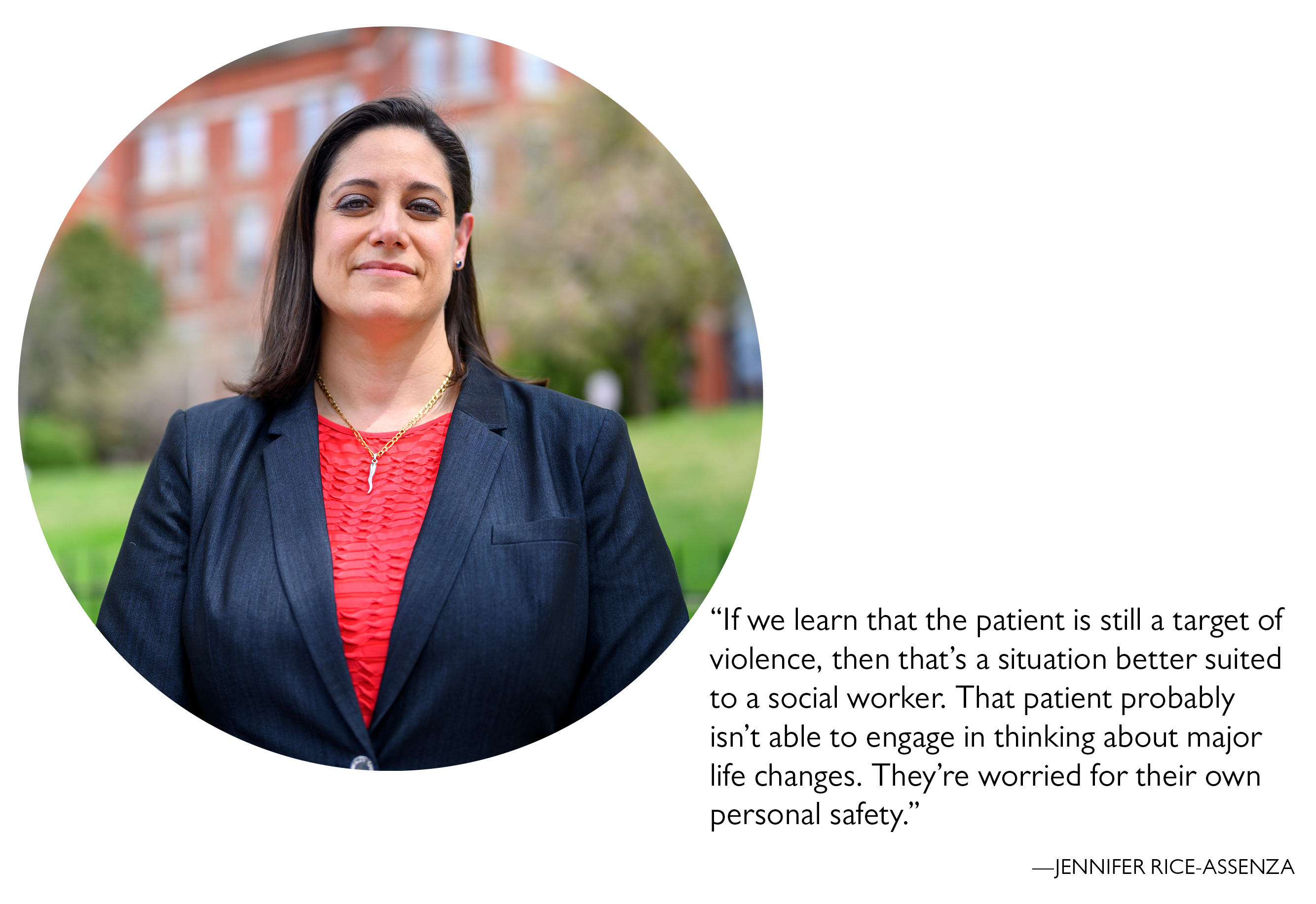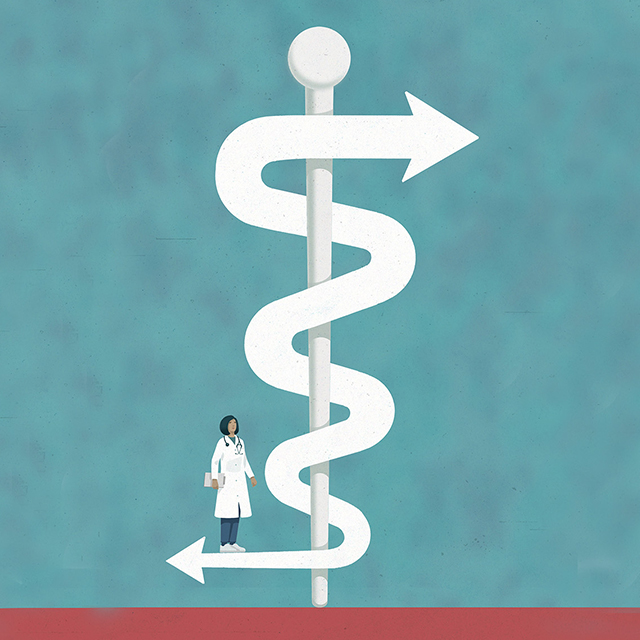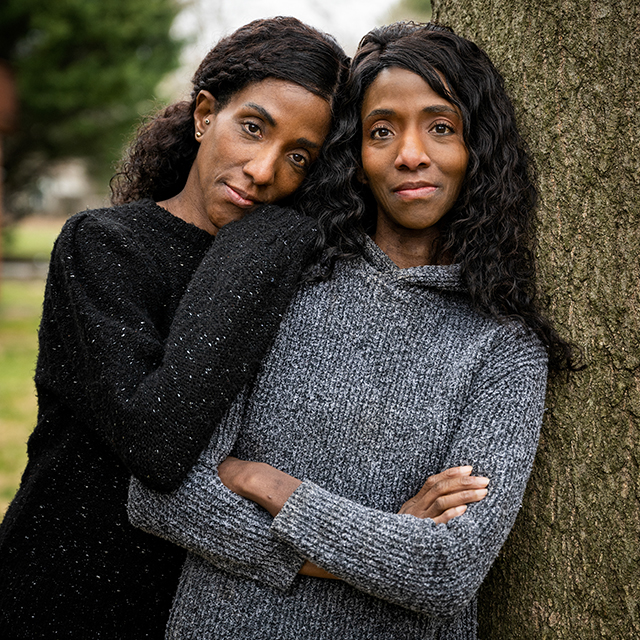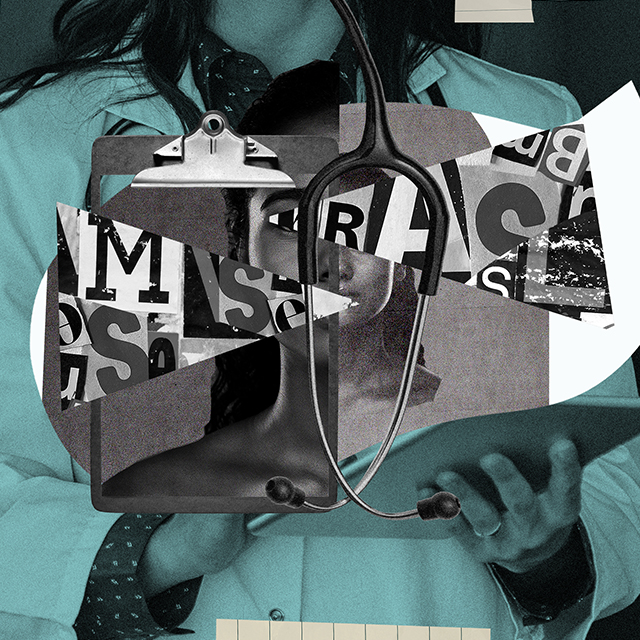Daniel Johnson* struggled to keep his eyes open, speeding his girlfriend’s car down East Baltimore’s bumpy streets. Still blocks away from The Johns Hopkins Hospital, he knew he was only minutes from bleeding to death.
Multiple gunshots had shattered the bones in the 24-year-old’s right forearm. Another broke a bone in his right leg. Others punctured flesh and ricocheted around inside Johnson’s body, tearing organs and blood vessels.
Driving with one arm and the wrong leg, he barreled the car toward the blue-and-green hospital towers and to the emergency entrance, trying desperately to stay conscious and alive.
“I was pretty sure if I passed out, I’d die,” he says quietly.
Sharing the Scars
Johnson (not his real name) is just one of hundreds of gunshot victims who make their way to The Johns Hopkins Hospital Emergency Department each year.
While most arrive by ambulance, “other times, a friend or loved one drives them, or they get here themselves. When that happens, they just come in through the front door, and we get them back to the trauma bays as quickly as we can,” says Johns Hopkins emergency medicine physician Nathan Irvin.
The waiting trauma team springs into action, stemming ongoing bleeding, stabilizing the patient’s blood pressure, and administering fluids or blood products. Those whose condition is not stable often need to go straight to an operating room, Irvin says. “A gunshot wound to the abdomen, for instance. That person’s probably going to need surgery right away.”
Irvin’s patients with gunshot injuries are nearly always Black men. Those with the most severe injuries sometimes don’t survive.
“It’s hard seeing death as often as we see it,” says Irvin, who is Black. “But it’s particularly hard when you see death that looks like your brothers or looks like your children.”
Research has shown that victims of shootings, stabbings or beatings are at significantly elevated risk of both re-injury and the commission of violence themselves.
As medical director of Break the Cycle, a hospital-based violence intervention program in place at The Johns Hopkins Hospital since 2019 for patients between 15 and 35, Irvin and his team see a way to interrupt the loop of violence that is ending so many promising young lives in Baltimore.
Break the Cycle and programs like it offered at medical centers around the country help victims of violence cope with deep psychological and emotional trauma — both from physical injuries and from living in violent environments — through the efforts of violence intervention specialists.
“There’s a golden opportunity, where these patients are introspective because they’ve just been through something very scary,” Irvin says. “We try to seize on those opportunities and put credible messengers in their lives who they can trust and who can partner with them on their journey to recovery.”
As Irvin notes, the key to Break the Cycle is that outreach team members come from the same communities and backgrounds as their clients.
Leonard Spain, who until recently served as a case manager for the program, says that one reason he had credibility with his clients is that he was himself a victim of gun violence in his 20s.
“That matters a lot,” says Spain, who left Break the Cycle for a new position in March. “If I show a client my scars, they know I’ve been where they are. And they can see that I got out of that mindset where I thought I had to escalate a bad situation.”
Dire Consequences
Generations of poverty, neglect and disinvestment, along with a deeply entrenched illegal drug trade and a seemingly never-ending supply of cheap, hard-to-trace handguns, have long fueled violent crime in Baltimore. In 2022, police reported 334 homicides in the city, more than 90% of which involved guns. In addition, there were 688 nonfatal shootings.
The east side, home to the Johns Hopkins medical campus, saw more than 100 homicides in 2022, nearly all of which were committed with handguns.
From July 1, 2022, through March 14, 2023, the hospital has treated 204 patients with gunshot wounds, 96 of whom were eligible for Break the Cycle. During the same period, there were 108 patients with stab wounds, 52 of whom qualified for help from the Break the Cycle team.
Much of the violence that sends patients to the Emergency Department stems from long-held grievances and retaliation for other violent encounters, says Kathy Wagner-Kosmakos, who, as care coordination and clinical resource program director, supports Break the Cycle.
“In a lot of these cases, there’s a really complex dynamic going on,” she says. “It’s important to recognize how trauma affects the clients’ way of thinking and the decisions they make. There’s just so much post-traumatic stress associated with violent injury, and connection to long-term counseling support is crucial.”
Patients under extreme stress need time to process the experience that landed them in the hospital.
“We strive to avoid retraumatizing the patient by throwing a lot of resources at them right away,” says Wagner-Kosmakos. “If we tell them, ‘You need to do this and that or else you’re probably going to get shot again and die,’ we risk making things worse. Establishing trust, providing support and building a relationship are the initial steps for the violence intervention specialist and our patient.”
She adds that gun violence has an outsized effect on the neighborhoods where it occurs.
“It’s a small percentage of the population that’s participating in gun violence,” Wagner-Kosmakos says. “But it has such dire consequences on the community, the families and, of course, the people who are injured.”
Irvin says it’s important to proceed at a pace the patient is comfortable with. “Patient empowerment and the provision of choice is particularly critical for individuals who have experienced trauma,” he says.
Planting a Seed
Providing that empowerment falls to hospital violence intervention specialists Nadir Abdullah and Ihsan Cornish, who work closely with Jennifer Rice-Assenza, a social worker and manager in the Department of Care Management.
“Our clients know that Nadir and I have seen a lot of stuff. That plays a big role in earning trust. It means connection and relatability. We know these environments and how they affect people,” says Cornish, who joined Break the Cycle last fall after working for four years as a perioperative equipment specialist in the Department of Surgery.
Both he and Abdullah spent time in the justice system as young adults.
After a stable early childhood, Cornish moved at age 9 with his family to Douglass Homes, a housing complex across Orleans Street from The Johns Hopkins Hospital. For generations, Douglass has been plagued by violence. Cornish says the atmosphere had a profound effect on him.
“I see now how it changed me,” he says. “Young kids in these environments get exposed to bad things they never would have seen or experienced [in healthier settings]. And then it becomes part of their world. I’ve seen good people in these situations get exposed to stuff that changes them forever.”
Abdullah spent his childhood in similar circumstances, across town in Lexington Terrace and Murphy Homes. After decades of notoriously poor living conditions and violence, Baltimore razed the two high-rise buildings in the 1990s.
“I’ve walked in some very dark places in my life,” says Abdullah, who has been employed at the hospital for 21 years, most recently as a patient services coordinator in the Department of Psychiatry and Behavioral Sciences.
“But now, I wholeheartedly believe I belong here. I can make a difference with our clients.”
He and Cornish are both well-versed in the resources available to their clients, whether those resources are based with government, nonprofits or Johns Hopkins. But they know that trying to push things like job training or GED courses on a person who’s recently been shot or stabbed is typically a futile endeavor. Emotional support is Break the Cycle’s first component.
“I feel like we plant a seed” in early client visits, Abdullah says. “And we allow that seed to germinate and grow into a relationship.”
During discussions with clients, they discuss conflict resolution strategies and identify “teachable moments,” where better decisions could help avoid situations that could become violent.
“We understand them. We were there too,” says Cornish. “We try to help them see that there really are other options.”
Rice-Assenza monitors Break the Cycle carefully and intervenes when a client’s needs are beyond the program’s scope.
“For example, if we learn that the patient is still a target of violence, then that’s a situation better suited to a social worker,” she says. “That patient probably isn’t able to engage in thinking about major life changes. They’re worried for their own personal safety.”
In cases like those, says Rice-Assenza, hospital social workers handle the case, making sure the patient has a safe hospital discharge plan when the time comes. She adds that patients who are at especially high risk of reinjury are sometimes better served by Break the Cycle’s community partners, organizations specifically devoted to working with people living with the trauma of interpersonal violence.
‘It Comes Down to Trust’
Trauma surgeon Joseph Sakran, director of emergency surgery and vice chair of clinical operations at The Johns Hopkins Hospital, has seen firsthand the value of Break the Cycle.
He stresses that academics and policymakers are only part of an effective violence prevention effort.
“Community is a critical part of the solution to tackling the problem of gun violence in Baltimore,” Sakran says. “I think that’s one of Break the Cycle’s strengths. I’m really sensitive to the idea of sitting within the walls of our hospital, telling the community what they need to do. They need to be integrated as true partners. It comes down to trust.”
Sakran speaks from experience when he talks with young patients who have experienced gun violence and their families.
As a high school senior in Northern Virginia, Sakran was struck when a gunman fired into a crowd of people after a high school football game. The bullet ruptured Sakran’s windpipe and severed his carotid artery. A trauma surgeon and a vascular surgeon along with their teams saved him and, as he recovered in Inova Fairfax Hospital, Sakran decided to dedicate himself to becoming a surgeon — and advocating for gun safety.
He has published extensively on gun violence and testified before Congress. Following a 2018 comment by the National Rifle Association that physicians should “stay in their lane” with regard to gun violence prevention, Sakran launched This Is Our Lane, a community of medical professionals dedicated to reducing firearm injuries and deaths. In 2019, he was named a Presidential Leadership Scholar for his research on safe gun storage and, in 2020, he was selected as a Robert Wood Johnson Foundation Health Policy Fellow, where he worked in the U.S. Senate.
Sakran says the “structural violence” of environments where people’s basic needs are not regularly met is a major factor in cities like Baltimore, where gun violence is so common.
“The conditions where we live, work and play affect a wide range of health risks and outcomes,” says Sakran. “It’s not just the prevalence of guns in the surrounding neighborhoods, but also the unsafe or unhealthy housing, limited nutrition options, high unemployment and so much more.”

Finding Strength
For many clients, including Daniel Johnson, the Break the Cycle team members aren’t just social workers or violence intervention specialists. They’re also friends.
After his harrowing drive to the Johns Hopkins Emergency Department that night in 2022, Johnson was rushed into surgery, where Johns Hopkins doctors tended to the damage Johnson sustained in the gunfire attack.
During his time as a Break the Cycle case worker, Leonard Spain visited Johnson in the early days of his recovery, slowly strengthening their connection with each ensuing visit.
Wearing khaki pants and a white polo shirt, Johnson swivels gently in a chair in Break the Cycle’s first-floor hospital office. He stops by the office from time to time, staying connected to the program. Today he’s just come from a class where he’s learning heating and air conditioning repair.
Slightly more than a year after nearly bleeding to death, Johnson remains wary of strangers and avoids direct eye contact. The wounds have healed, leaving behind scars and bullet fragments: a mark on his right cheek. A bump near his left jaw where a bullet remains. Next to an ornate tattoo of the word “loyalty” on his right forearm is a deep, hollowed-out discoloration where surgeons repaired the damage done by a bullet. His clothes hide more such scars. When Johnson responds to questions, he holds his head low, tilted to one side.
But the Break the Cycle team members induce a different, friendlier demeanor from Johnson. They pepper him with encouragement, jokes and good-natured teasing, bringing the reserved East Baltimore native to life.
Johnson sees a therapist regularly and continues to process the trauma he has experienced. Soon to graduate from the HVAC course that Break the Cycle helped him find, Johnson hopes his new skills, along with other job training programs, will lead to full-time employment.
When Johnson encounters situations that he fears could lead to trouble, the Break the Cycle team is his first phone call. He credits the program with helping him “find the strength to stay away from all that.”
Johnson and his girlfriend are expecting a baby boy in a few months. He breaks a shy smile at the notion of becoming a father.
“I want to be around for my child,” he says in a soft voice.


